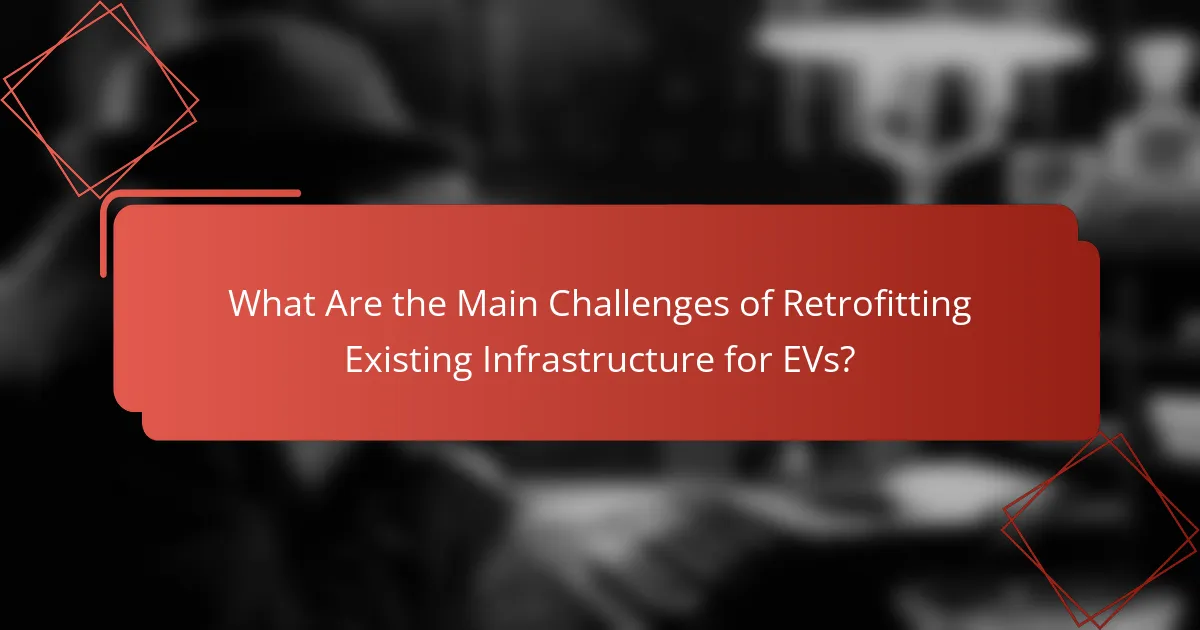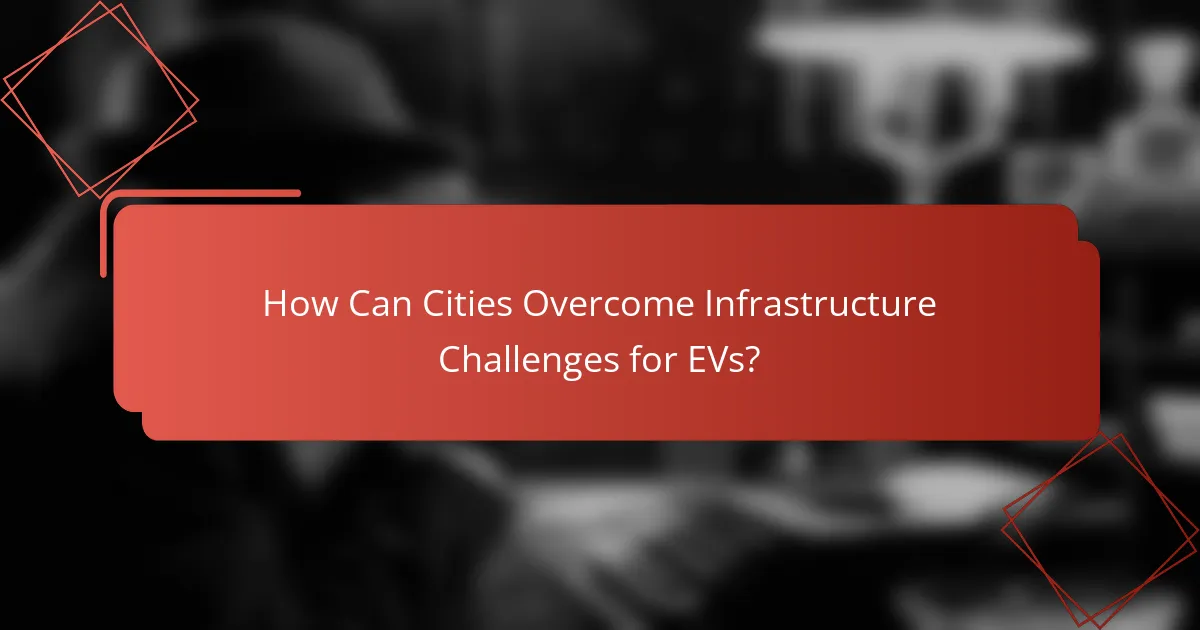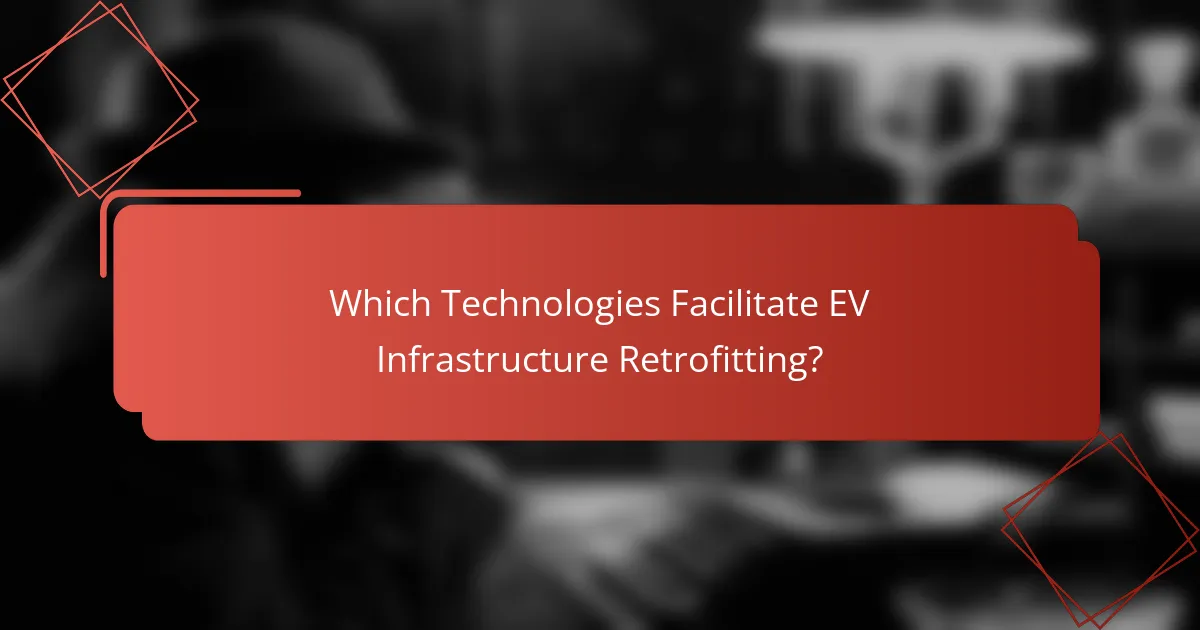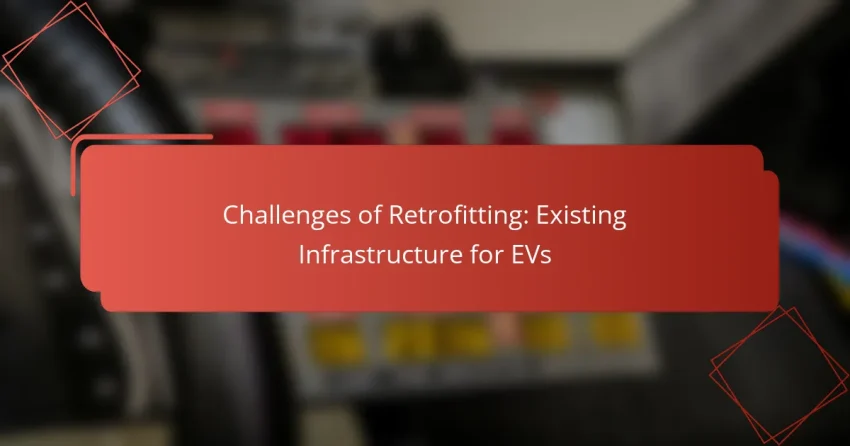Retrofitting existing infrastructure for electric vehicles (EVs) poses several significant challenges, such as the need for additional charging stations, high upgrade costs, and regulatory hurdles. Successfully addressing these issues is essential for facilitating the transition to electric mobility and enhancing the feasibility of EV adoption. By implementing innovative solutions and engaging stakeholders, cities can improve the availability and efficiency of charging infrastructure.

What Are the Main Challenges of Retrofitting Existing Infrastructure for EVs?
Retrofitting existing infrastructure for electric vehicles (EVs) presents several significant challenges, including the need for more charging stations, high upgrade costs, regulatory hurdles, compatibility with legacy systems, and public resistance. Addressing these issues is crucial for a successful transition to electric mobility.
Insufficient Charging Stations
The lack of adequate charging stations is a primary challenge in retrofitting infrastructure for EVs. Many urban and rural areas still have limited access to charging facilities, which can deter potential EV users. Expanding the network of charging stations requires strategic planning and investment.
To effectively address this, stakeholders should consider installing charging points in high-traffic areas, such as shopping centers and public parking lots. Collaborating with local governments and private businesses can help increase the availability of charging options.
High Costs of Upgrades
Upgrading existing infrastructure to accommodate EVs can be costly. Expenses may include installing new electrical systems, upgrading transformers, and ensuring that charging stations meet safety standards. These costs can be a significant barrier for municipalities and businesses.
To manage expenses, entities can explore funding opportunities, such as government grants or partnerships with private companies. Conducting a cost-benefit analysis can also help prioritize which upgrades will yield the best return on investment.
Regulatory Barriers
Regulatory barriers often complicate the retrofitting process for EV infrastructure. Local zoning laws, building codes, and utility regulations can hinder the installation of charging stations. Navigating these regulations requires careful planning and coordination with various governmental bodies.
Stakeholders should engage with local authorities early in the planning process to identify potential regulatory challenges. Staying informed about changes in legislation related to EV infrastructure can also help streamline the retrofitting process.
Compatibility Issues with Legacy Systems
Many existing electrical systems may not be compatible with the demands of EV charging. Legacy infrastructure can struggle to support the increased load from multiple charging stations, leading to reliability issues. Upgrading these systems can be both complex and expensive.
To mitigate compatibility issues, a thorough assessment of current infrastructure is essential. This can help identify necessary upgrades and ensure that new installations are designed to work seamlessly with existing systems.
Public Resistance to Change
Public resistance can pose a significant challenge to retrofitting efforts. Many individuals may be hesitant to adopt EVs due to concerns about charging availability, range anxiety, or the perceived inconvenience of switching from traditional vehicles. Overcoming this resistance is key to successful infrastructure changes.
Effective public outreach and education campaigns can help address misconceptions about EVs and charging infrastructure. Highlighting the environmental benefits and potential cost savings of EVs can also encourage more people to make the transition.

How Can Cities Overcome Infrastructure Challenges for EVs?
Cities can address infrastructure challenges for electric vehicles (EVs) by implementing innovative solutions, securing funding, and forming strategic partnerships. These approaches can enhance the availability and efficiency of charging stations, making EV adoption more feasible for residents.
Implementing Smart Charging Solutions
Smart charging solutions optimize the use of existing electrical infrastructure by managing when and how EVs are charged. These systems can reduce peak demand on the grid and lower electricity costs for users by scheduling charging during off-peak hours.
For instance, cities can install smart meters that allow EV owners to charge their vehicles at lower rates during nighttime. This not only saves money but also encourages more drivers to switch to electric vehicles.
Leveraging Federal Grants and Incentives
Federal grants and incentives can significantly alleviate the financial burden on cities looking to enhance EV infrastructure. Programs such as the U.S. Department of Energy’s funding initiatives provide resources for the installation of charging stations and upgrades to electrical systems.
Cities should actively seek out these funding opportunities and consider applying for multiple grants to maximize their resources. This approach can cover a substantial portion of the costs associated with retrofitting existing infrastructure.
Collaborating with Private Sector Partners
Collaboration with private sector partners can accelerate the deployment of EV infrastructure. Businesses, especially those in the energy and automotive sectors, often have the expertise and resources to support infrastructure development.
For example, partnerships with charging network providers can lead to the installation of more charging stations in high-traffic areas, improving accessibility for EV users. Cities should explore joint ventures or sponsorships that can enhance their infrastructure without solely relying on public funds.

What Are the Key Considerations for Retrofitting Projects?
Retrofitting existing infrastructure for electric vehicles (EVs) involves several critical considerations, including assessing current capabilities, conducting cost-benefit analyses, and engaging stakeholders effectively. Each of these factors plays a significant role in determining the feasibility and success of retrofitting initiatives.
Assessment of Current Infrastructure
Evaluating the existing infrastructure is essential to identify what modifications are necessary for accommodating EVs. This includes examining the current electrical capacity, parking facilities, and accessibility of charging stations. Understanding these elements helps determine the extent of upgrades required.
For instance, older buildings may need significant electrical system enhancements to support the additional load from EV chargers. Conducting a thorough audit can reveal potential challenges and opportunities for improvement.
Cost-Benefit Analysis
A comprehensive cost-benefit analysis is crucial for weighing the financial implications of retrofitting against the potential benefits. This analysis should include initial investment costs, ongoing maintenance expenses, and projected savings from energy efficiency and reduced emissions.
Consideration of available incentives, such as government grants or tax credits for EV infrastructure, can significantly influence the overall financial outlook. A well-structured analysis can aid decision-makers in prioritizing projects that offer the best return on investment.
Stakeholder Engagement Strategies
Engaging stakeholders is vital for the successful implementation of retrofitting projects. This includes local government, utility companies, and community members who may be affected by the changes. Establishing open lines of communication can foster collaboration and support.
Strategies may involve hosting public meetings, conducting surveys, and forming partnerships with local businesses. By actively involving stakeholders, project leaders can address concerns, gather valuable insights, and build a sense of community ownership over the retrofitting initiative.

Which Technologies Facilitate EV Infrastructure Retrofitting?
Several technologies play a crucial role in retrofitting existing infrastructure for electric vehicles (EVs). These innovations enhance the efficiency and accessibility of charging solutions, making it easier to integrate EVs into current systems.
Smart Grid Technology
Smart grid technology optimizes energy distribution and management, making it essential for EV infrastructure retrofitting. It allows for real-time monitoring and control of electricity flow, which can help balance supply and demand, especially during peak charging times.
Implementing smart grids involves upgrading existing electrical systems with advanced metering infrastructure and communication technologies. This can facilitate demand response strategies, enabling utilities to manage EV charging loads effectively and reduce strain on the grid.
Battery Storage Systems
Battery storage systems are vital for enhancing the reliability of EV charging infrastructure. They store excess energy generated during low-demand periods and release it during peak times, ensuring that charging stations remain operational even when grid power is limited.
When retrofitting, consider integrating battery storage solutions that can handle varying capacities, typically ranging from tens of kilowatt-hours to several megawatt-hours. This flexibility allows for tailored solutions based on local energy needs and charging station usage patterns.
Mobile Charging Solutions
Mobile charging solutions provide a flexible approach to EV infrastructure retrofitting, offering on-demand charging capabilities. These systems can be deployed quickly to address specific needs, such as events or areas with limited fixed charging stations.
Options include portable chargers and charging vans that can deliver power directly to vehicles. When considering mobile solutions, assess the charging speed and compatibility with various EV models to ensure broad usability and efficiency.

What Are the Best Practices for Retrofitting Existing Infrastructure?
Best practices for retrofitting existing infrastructure for electric vehicles (EVs) involve assessing current capabilities, integrating charging solutions, and ensuring compatibility with future technologies. Effective retrofitting enhances usability and promotes the transition to electric mobility.
Assessing Current Infrastructure
Evaluating existing infrastructure is crucial before retrofitting. This includes examining the condition of roads, parking facilities, and power supply systems. Identify areas that require upgrades to accommodate EV charging stations and ensure they meet local regulations.
Consider the geographic distribution of current infrastructure. Urban areas may need more charging stations than rural regions, while high-traffic locations should prioritize accessibility. A thorough assessment can guide effective resource allocation.
Integrating Charging Solutions
Integrating charging solutions into existing infrastructure requires careful planning. Options include installing Level 2 chargers for residential areas and fast chargers for public locations. Each type has different power requirements and installation costs, typically ranging from a few hundred to several thousand USD.
Collaboration with local utilities can facilitate the installation process. They can provide insights on grid capacity and potential incentives for upgrading electrical systems. Additionally, consider implementing smart charging solutions that optimize energy use and reduce costs.
Ensuring Compatibility with Future Technologies
Future-proofing retrofitted infrastructure is essential for long-term viability. This involves selecting adaptable charging systems that can accommodate advancements in EV technology, such as wireless charging or ultra-fast charging capabilities. Planning for scalability can save costs and effort in the future.
Stay informed about evolving standards and regulations in the EV sector. Engaging with industry groups can provide valuable insights into upcoming trends and technologies, ensuring that retrofitting efforts remain relevant and effective over time.
